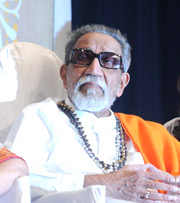
Bal Keshav Thackeray, also known as Balasaheb Thackeray, was an Indian politician who founded the Shiv Sena, a right-wing pro-Marathi and Hindu nationalist party active mainly in the state of Maharashtra.
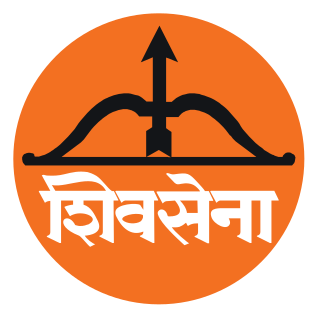
Shiv Sena is a right-wing Marathi regionalist and Hindu ultranationalist political party in India founded in 1966 by Bal Thackeray. Currently led by Eknath Shinde, this party is the ruling party of the Indian state of Maharashtra since 2019. Shiv Sena's election symbol is the Bow and Arrow. It uses the saffron colour in its flag and a image of a roaring tiger.

Persecution is the systematic mistreatment of an individual or group by another individual or group. The most common forms are religious persecution, racism, and political persecution, though there is naturally some overlap between these terms. The inflicting of suffering, harassment, imprisonment, internment, fear or pain are all factors that may establish persecution, but not all suffering will necessarily establish persecution. The threshold of severity has been a source of much debate.

The Times of India, also known by its abbreviation TOI, is an Indian English-language daily newspaper and digital news media owned and managed by The Times Group. It is the fourth-largest newspaper in India by circulation and largest selling English-language daily in the world. It is the oldest English-language newspaper in India, and the second-oldest Indian newspaper still in circulation, with its first edition published in 1838. It is nicknamed as "The Old Lady of Bori Bunder", and is an Indian "newspaper of record".
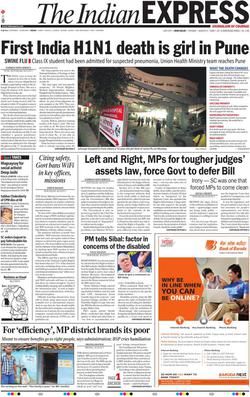
The Indian Express is an English-language Indian daily newspaper founded in 1932 by Ramnath Goenka with an investment by capitalist partner Raja Mohan Prasad. The company is held in a trust by current legal heirs for Prasad's family as per the trust deed given by Goenka to Prasad. It is published in Mumbai by the Indian Express Group. In 1999, eight years after Goenka's death in 1991, the group was split between the family members. The southern editions took the name The New Indian Express, while the northern editions, based in Mumbai, retained the original Indian Express name with The prefixed to the title.
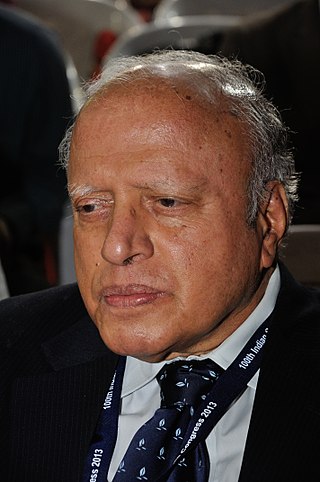
Mankombu Sambasivan Swaminathan was an Indian Agronomist, Agricultural scientist, Geneticist, Administrator and Humanitarian. Swaminathan was a global leader of the green revolution. He has been called the main architect of the green revolution in India for his leadership and role in introducing and further developing high-yielding varieties of wheat and rice. Swaminathan's collaborative scientific efforts with Norman Borlaug, spearheading a mass movement with farmers and other scientists and backed by public policies, saved India and Pakistan from certain famine-like conditions in the 1960s. His leadership as director general of the International Rice Research Institute (IRRI) in the Philippines was instrumental in his being awarded the first World Food Prize in 1987, recognized as one of the highest honours in the field of agriculture. The United Nations Environment Programme has called him "the Father of Economic Ecology". He was recently conferred the Bharat Ratna, the highest civilian award of the Republic of India, in 2024.

Rasipuram Krishnaswami Iyer Laxman was an Indian cartoonist, illustrator, and humorist. He is best known for his creation The Common Man and for his daily cartoon strip, You Said It in The Times of India, which started in 1951.
The Khilafat movement (1919–22) was a political campaign launched by Indian Muslims in British India over British policy against Turkey and the planned dismemberment of the Ottoman Empire after World War I by Allied forces.

The caliphate of the Ottoman Empire was the claim of the heads of the Turkish Ottoman dynasty to be the caliphs of Islam in the late medieval and early modern era. During the period of Ottoman expansion, Ottoman rulers claimed caliphal authority after the conquest of Mamluk Egypt by sultan Selim I in 1517 and the abolition of the Mamluk-controlled Abbasid Caliphate. This left Selim as the Defender of the Holy Cities of Mecca and Medina and strengthened the Ottoman claim to leadership in the Muslim world.

The Sir Jamsetjee Jeejeebhoy School of Art is the oldest art institution in Mumbai, India, and is affiliated with the University of Mumbai. The school grants bachelor's (B.F.A) degrees in Painting, ceramic, Metal work, Interior decoration, Textile design and Sculpture as well as Master's degrees (M.F.A) in Portraiture, Creative Painting, Murals, Sculpture, and Printmaking.

The New Indian Express is an Indian English-language broadsheet daily newspaper published by the Chennai-based Express Publications. It was founded in 1932 as The Indian Express, under the ownership of Chennai-based P. Varadarajulu Naidu and was bought by Ramnath Goenka from the monies of capitalists partner Raja Mohan Prasad and is held in trust by the current legal heirs for the family of Raja Mohan Prasad as per the trust deed given by Ramnath Goenka to Raja Mohan Prasad. In 1991, following the death of owner Ramnath Goenka, his family split the group into two companies. Initially, the two groups shared the Indian Express title, as well as editorial and other resources. But on 13 August 1999, the northern editions, headquartered in Mumbai, retained the Indian Express moniker, while the southern editions became The New Indian Express.
Seema Mustafa is an Indian print and television journalist. She is currently the Editor-in-Chief of The Citizen, a digital newspaper she founded. She is the elected president of the Editors Guild of India, since 16 October 2020.
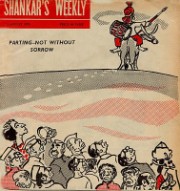
Shankar's Weekly was an Indian satirical magazine published between 1948 and 1975. It was founded and run by Keshav Shankar Pillai, a pioneering political cartoonist. The magazine has been compared to the UK's Punch.

Thayil Jacob Sony George is an Indian writer and biographer who received a Padma Bhushan award in 2011 in the field of literature and education. The fourth of eight siblings, TJS was born in Kerala, India to Thayil Thomas Jacob, a magistrate, and Chachiamma Jacob, a homemaker. Although his roots are in Thumpamon, Kerala, he lives in Bangalore and Coimbatore with his wife Ammu. He has a daughter, Sheba Thayil and a son, Jeet Thayil. American TV journalist Raj Mathai is his nephew.
Marmik meaning: [Straight from the heart/A silent word that goes directly to the Heart] is an Indian weekly published by the Shiv Sena from Mumbai, until publication of its daily Saamana it was Shiv Sena's organ. It is seen as the frontrunner or launchpad for the Shiv Sena party. It focused on issues of common Marathi man or Maratha Manoos including unemployment, influx of migrant, retrenchment of Marathi workers and its office in Ranade Road became the rallying point for Marathi youth. It was Marmik issue on 5 June 1966 which first announced the launch of membership for the Shiv Sena. Bal Thackeray later stated "that not just a cartoon weekly but also the prime reason for the birth and growth of the Sena.".
Swaminathan Sadanand (1900–1953) was an Indian journalist.
Free Press of India was an Indian nationalist-supporting news agency founded in the 1920s by Swaminathan Sadanand, during the period of the British Raj. It was the first news agency owned and managed by Indians. Beset by dubious business acumen from the outset, and beholden to those who financed it, the agency failed to obtain substantial support from Indian-owned press and hence closed down in 1935. It was revived briefly between 1945 and 1947 before being stifled by the government of the newly independent country. It was at various times a supporter of the Swaraj Party and, later, of the Responsive Cooperation Party, as well as various business interests.

The Greatest Indian was a poll sponsored by Reliance Mobile and conducted by Outlook magazine, in partnership with CNN-IBN and The History Channel. The poll was conducted from June to August 2012, with the winner, B. R. Ambedkar, announced on 11 August. A program associated with the poll aired from 4 June until 15 August.
There have been several instances of religious violence against Muslims since the partition of India in 1947, frequently in the form of violent attacks on Muslims by Hindu nationalist mobs that form a pattern of sporadic sectarian violence between the Hindu and Muslim communities. Over 10,000 people have been killed in Hindu-Muslim communal violence since 1950 in 6,933 instances of communal violence between 1954 and 1982.
Editors Guild of India (EGI) is a non-profit organisation of journalists, particularly the Editors, based in India. The organization has declared "objectives of protecting press freedom and for raising the standards of editorial leadership of newspapers and magazines". It was founded in 1978, by Kuldip Nayar. EGI has represented Indian newspapers in communications to the government.












